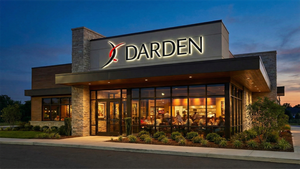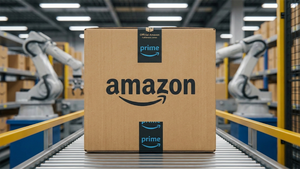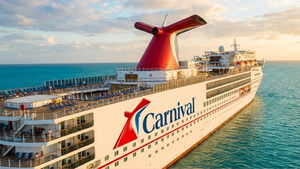
Packaged foods company Conagra Brands (NYSE: CAG) missed Wall Street’s revenue expectations in Q2 CY2025, with sales falling 4.3% year on year to $2.78 billion. Its non-GAAP profit of $0.56 per share was 8.2% below analysts’ consensus estimates.
Is now the time to buy CAG? Find out in our full research report (it’s free).
Conagra (CAG) Q2 CY2025 Highlights:
- Revenue: $2.78 billion vs analyst estimates of $2.83 billion (4.3% year-on-year decline, 1.7% miss)
- Adjusted EPS: $0.56 vs analyst expectations of $0.61 (8.2% miss)
- Adjusted EBITDA: $544 million vs analyst estimates of $511.5 million (19.6% margin, 6.4% beat)
- Adjusted EPS guidance for the upcoming financial year 2026 is $1.78 at the midpoint, missing analyst estimates by 27.6%
- Operating Margin: 14%, up from -19.1% in the same quarter last year
- Organic Revenue fell 4.3% year on year (-2.4% in the same quarter last year)
- Sales Volumes fell 2.5% year on year, in line with the same quarter last year
- Market Capitalization: $9.30 billion
StockStory’s Take
Conagra's second quarter faced notable headwinds, drawing a negative market response as both revenue and adjusted earnings per share came in below Wall Street expectations. Management attributed the underperformance to persistent inflationary pressures, particularly in animal protein inputs and packaging, as well as lingering supply chain constraints that impacted production in core categories like frozen foods and snacks. CEO Sean Connolly acknowledged, “the confluence of high inflation and higher investment to drive volume translates to temporary margin compression,” highlighting the deliberate trade-off between supporting brand strength and short-term profitability.
Looking forward, Conagra’s guidance reflects a cautious stance as management anticipates continued cost inflation and investment in supply chain resiliency. The company plans to prioritize volume recovery in its frozen and snack segments, even if this results in near-term margin pressure. Connolly emphasized, “we are investing margin this year in the service of volume,” while CFO Dave Marberger noted that supply chain investments, including expanding chicken processing capacity, are expected to support future growth. However, management remains wary of ongoing tariff impacts and the need to balance pricing actions with consumer sensitivity.
Key Insights from Management’s Remarks
Management pointed to several factors behind the recent quarter’s results, including cost inflation, category-specific volume pressures, and portfolio adjustments through divestitures.
- Persistent cost inflation: CFO Dave Marberger outlined that core input costs, especially animal proteins and packaging, continued to rise at double-digit rates, creating a significant drag on profitability and forcing Conagra to absorb rather than pass on much of the increase to consumers.
- Supply chain investments: The company faced ongoing supply chain constraints, particularly in chicken processing, which limited its ability to meet consumer demand for high-performing frozen products. Management is investing in both facilities and automation to increase resilience and efficiency.
- Portfolio reshaping: Recent divestitures, such as Chef Boyardee and select fish brands, reflect Conagra’s ongoing strategy to focus on higher-growth frozen and snack categories while using cash-generating businesses like canned foods to fund these priorities.
- Targeted pricing and merchandising: Management explained a differentiated approach, with margin investment and innovation driving growth in frozen and snacks, while selective price increases in canned foods offset tariff-related cost pressures. The company aims to maintain competitiveness in categories where private label brands are significant.
- Product innovation focus: New product launches, like Banquet Mega Chicken Fillets, demonstrated strong consumer reception and highlight Conagra’s efforts to premiumize its portfolio, especially by introducing multi-serve packaging and enhancing product quality across its frozen segment.
Drivers of Future Performance
Management expects near-term growth to be shaped by ongoing cost inflation, targeted investments in supply chain, and a focus on recovering core volumes.
- Volume recovery in key segments: Conagra’s strategy centers on rebuilding volume in frozen and snacks through increased marketing, innovation, and improved service levels. Management views healthy volumes in these areas as essential for long-term brand value and future cash flow generation.
- Margin expansion contingent on productivity: The company is counting on supply chain modernization, automation, and productivity gains—including AI-driven process improvements—to offset inflation and drive operating margin recovery in future years.
- Tariff and input cost risks: Management recognizes that tariffs on tinplate steel and ongoing input cost inflation remain significant uncertainties, particularly for the canned foods segment. The company’s ability to execute targeted price increases and mitigate these risks will be critical for achieving margin improvement.
Catalysts in Upcoming Quarters
In the coming quarters, our analysts will focus on (1) the pace of volume recovery in frozen and snack brands as supply chain investments come online, (2) Conagra’s ability to offset cost inflation and tariffs through productivity and targeted pricing, and (3) further portfolio adjustments or divestitures aimed at concentrating on higher-growth categories. We also view execution of new product launches and supply chain projects as important markers for sustained improvement.
Conagra currently trades at $19.50, down from $20.37 just before the earnings. Is there an opportunity in the stock?Find out in our full research report (it’s free).
Stocks That Trumped Tariffs
Market indices reached historic highs following Donald Trump’s presidential victory in November 2024, but the outlook for 2025 is clouded by new trade policies that could impact business confidence and growth.
While this has caused many investors to adopt a "fearful" wait-and-see approach, we’re leaning into our best ideas that can grow regardless of the political or macroeconomic climate. Take advantage of Mr. Market by checking out our Top 5 Strong Momentum Stocks for this week. This is a curated list of our High Quality stocks that have generated a market-beating return of 183% over the last five years (as of March 31st 2025).
Stocks that made our list in 2020 include now familiar names such as Nvidia (+1,545% between March 2020 and March 2025) as well as under-the-radar businesses like the once-small-cap company Exlservice (+354% five-year return). Find your next big winner with StockStory today.
StockStory is growing and hiring equity analyst and marketing roles. Are you a 0 to 1 builder passionate about the markets and AI? See the open roles here.




